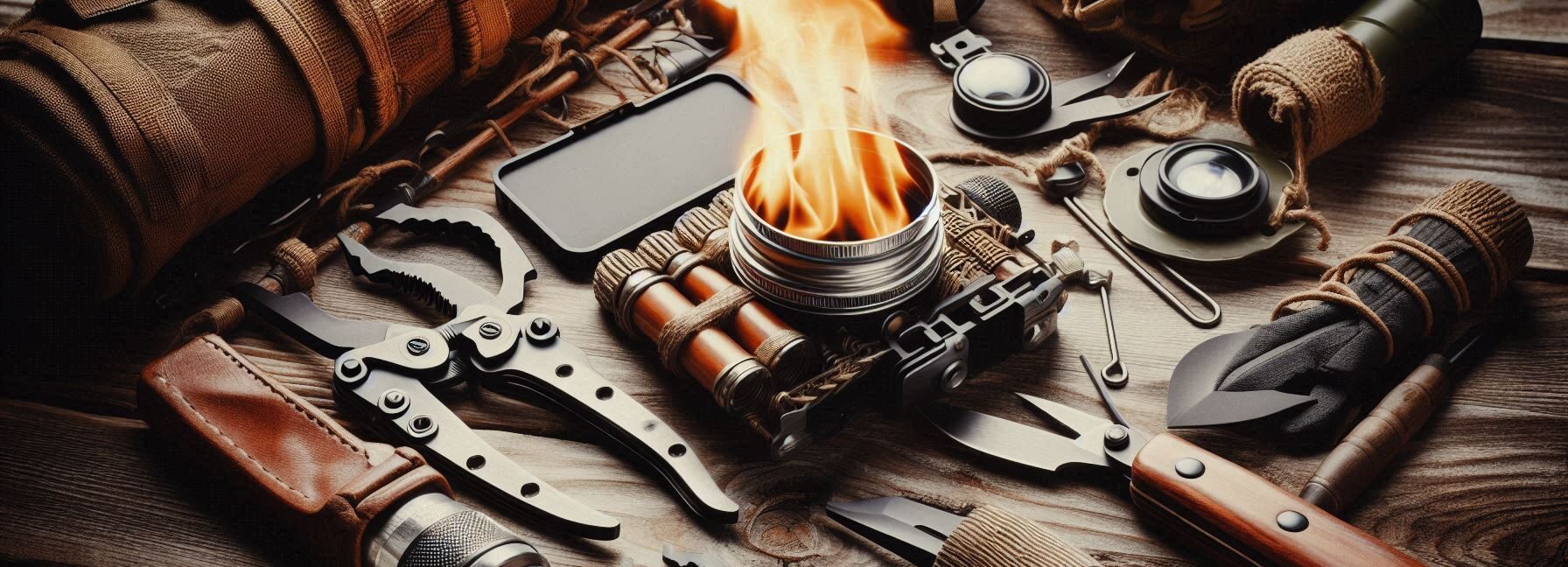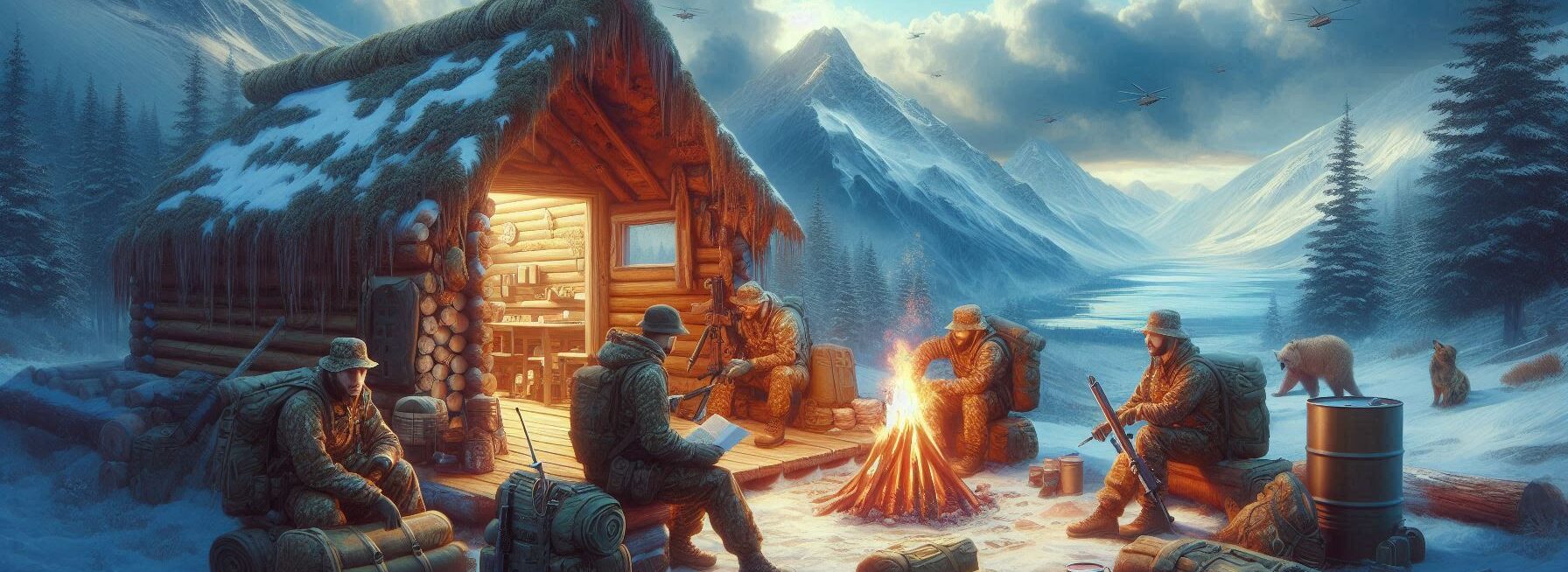Please Note: This post may contain affiliate links. If you click one of them, we may receive a commission at no extra cost to you. As an Amazon Associate, I earn from qualifying purchases.
Last Updated on October 19, 2025 by Kevin Collier
Hiking and camping are two of the best ways to experience nature when you want to be outside. No matter how much experience you have, there is always something new to learn. I mean, who hasn't packed six pairs of socks but forgot the marshmallows? Now, let's get into some useful advice that will make your next trip more pleasant and less stressful!
Top Takeaways and Key Concepts
– Plan route, check weather, share itinerary, set turnaround time.
– Pack Ten Essentials; test gear; keep load under 20% bodyweight.
– Layer clothing; stay dry; manage sweat; change socks promptly.
– Hydrate on schedule; treat all water; eat calorie-dense snacks.
– Leave No Trace; camp 200 feet from water; secure food properly.
Choosing the Right Gear

First things first: gear is important! It's really important to get the correct gear, because you wouldn't wear flip-flops on a mountain route (unless you want to tell an epic fail story). Your best companion might be a good pair of hiking boots. They give you support and grip, which are two things you really need while you're walking on rough or muddy trails.
Don't forget about your backpack when you talk about gear! It should fit well, but not so tightly that it feels like a boa constrictor around your waist. Find one with padded straps. After a few kilometers, you'll be glad you did since your shoulders won't feel like they're carrying a boulder. And while we're at it, pack smart! Make sure that things like food and water bottles are easy to get to. No one wants to stop in the middle of a hike to look for their granola bar.
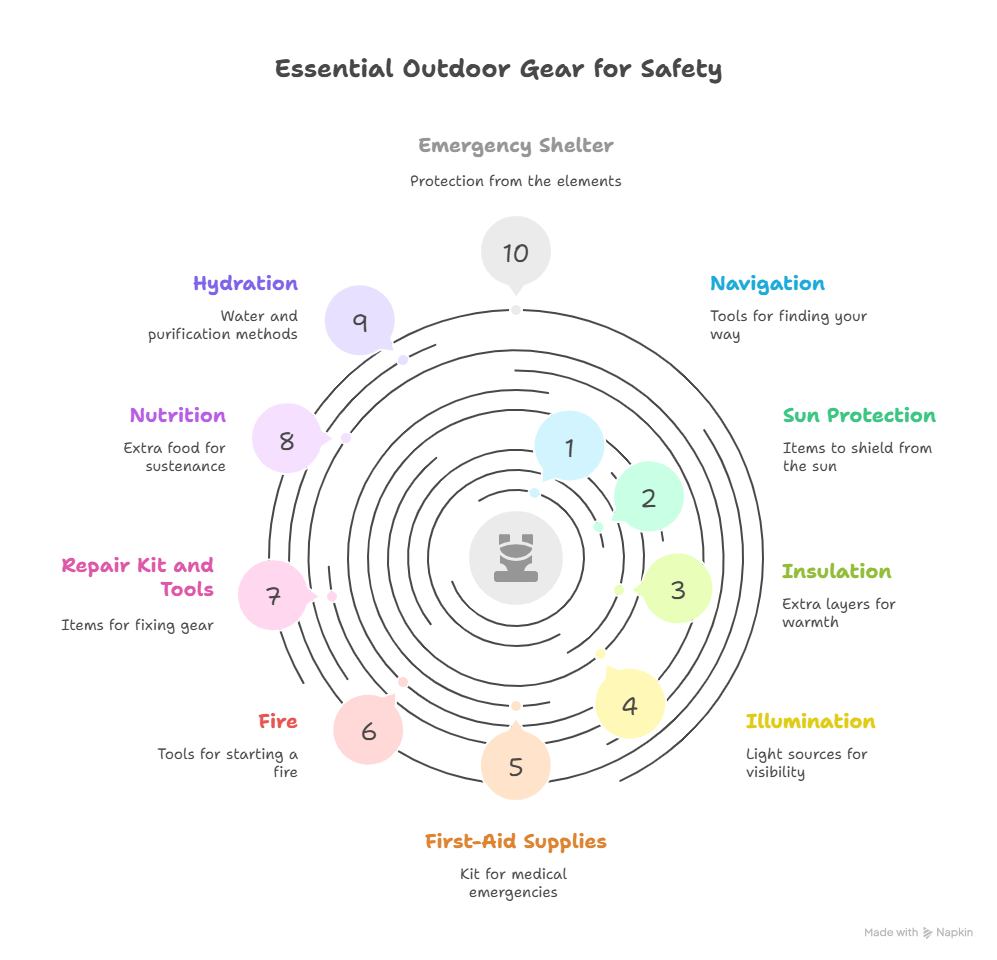
And let's also discuss about what to wear! When you're outside, it's important to dress in layers since, let's be honest, Mother Nature can be dramatic. One minute it's sunny and comfortable, and the next you're caught in an unexpected rain shower that soaks you to the bone. You may simply adapt to any weather surprises that come your way by layering your clothes. It's like being a human onion!
Your first layer should be a light shirt that wicks away moisture. This amazing fabric pushes sweat away from your skin, which keeps you dry and comfortable. I mean, who wants to feel like they're swimming while hiking? No way! Put on a warm fleece jacket or an insulated vest that you can throw on as the temperature drops or the cold wind starts to creep up on you.
Now we need to talk about something important: cotton isn't good for you when you're outside. For real! Cotton may seem warm and cozy at home, but when it gets wet (and trust me, it will), it gets heavy and takes a long time to dry. You might as well be wearing a wet towel! Instead, choose synthetic fabrics or wool blends that dry fast and keep you warm even when they're wet.
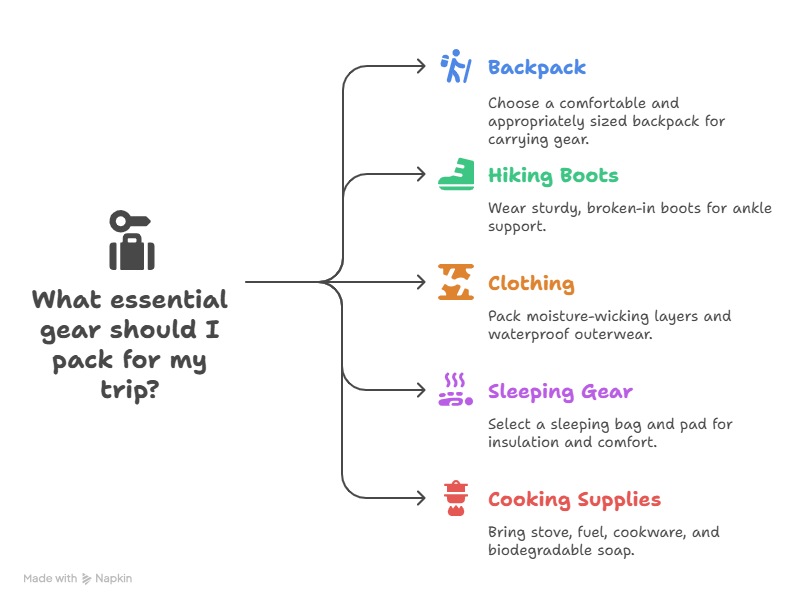
*** Shop for Survival Gear - Tools - Kits ***
Survival Gear - Bags and Backpacks - Knives - Boots/Footwear - Communication
Outdoor Cooking - Gloves - Hydration - Dry Boxes - Water Filtration Systems
Tents - Sleeping Bags - First Aid Kits - Multi-Tools - Flashlights - Fire Starters
Navigation - Survival Food - Night Vision - Headlamps - Stun Guns - Binoculars
Don't forget about the coating on the outside! If the skies suddenly open up, a decent waterproof jacket can save your life. Find one that lets air in so you don't feel like you're stuck in a plastic bag when you trek up a sweaty hill. Hats are great for keeping the sun off your face or keeping the rain off your face. And let's be honest, who doesn't want to seem like they're up for an adventure?
Footwear also deserves a shout-out! To hike on rocky routes without getting sore feet on the second day of your trip, you need to wear comfortable hiking boots. Check to see if they fit well. If they're too tight, you'll be in pain with every step. If they're too loose, you'll feel like you're trying to hike in clown shoes!
In summary, dressing smartly entails planning ahead how each layer will work together while keeping comfort in mind. So, get rid of the cotton shirts and put on the moisture-wicking ones. Get ready for whatever outdoor fun is coming your way. You'll be glad you did when you're enjoying the view instead of worrying about whether you've turned into a walking sponge!
Planning Your Route

Now that you have all your gear in order, let's talk about how to plan your route. This stage is just as vital as picking out the snacks to bring (and we all know how important that is). Before you leave, look at the trail map. Yes, those paper things still exist, even though we always have our phones in our hands!
You might be wondering why this is important. Imagine hiking happily only to find yourself lost in the woods and wondering if bears have started to like hikers lately. To avoid getting lost in bear territory or worse, it's a good idea to always tell someone where you're going before you leave.
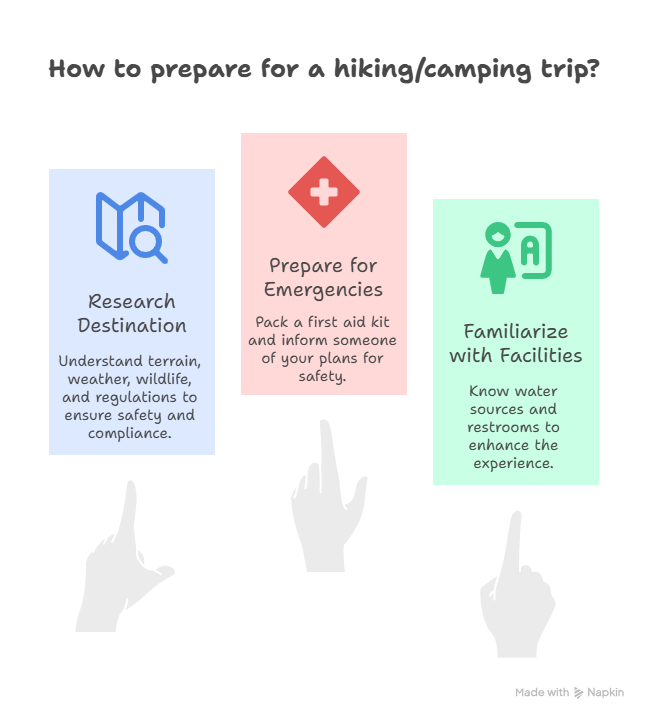
Also, think about checking the trail conditions ahead of time! This is one of those important things you can do to avoid a day of disappointment. Picture getting ready for an awesome journey by putting on your favorite hiking boots, packing all your food (because, let's be honest, munchies are the real MVPs), and setting out with great aspirations. Only to go to the trailhead and find out that it is closed because of bad weather or repairs. What a bummer!
I know what you're thinking: “How bad could it really be?” But trust me, certain routes may become wetlands after a lot of rain. You might wind up splashing around in muddy puddles like a big kid at a water park. It would be wonderful for about five minutes until you realize your shoes are drenched and they squelch with every step! And unless you're trying out for a new reality show called “Survivor: Swamp Edition,” that's probably not how you thought your hike would go.
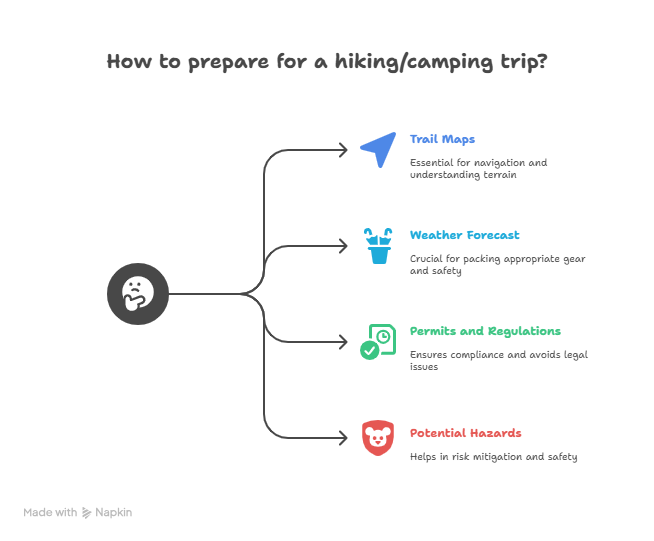
So, where do you go to find out about these hard-to-find trail conditions? Most parks have websites or social media profiles where you can find out about closures and the current state of things. There are also hiking applications that let you see what other hikers are up to in real time. It's like having a personal scout, but without the awkward small talk!
Also, don't forget to think about the seasons! Some trails may be closed at particular periods of the year because of animals or efforts to protect them. If you want to visit some cute baby animals but accidentally walk into their nursery without checking first, let's just say that won't end well for either of you.

Also, keep an eye on the weather reports before you go hiking. It might still be muddy or treacherous on the route, even if it hasn't been officially closed. Believe me, no one wants to play slip-and-slide on their way up a mountain!
In short, just a few minutes to check the trail conditions can mean the difference between a fun visit and a surprise swamp party, or worse, a long drive home with damp socks and frustrated ambitions of conquering nature's grandeur. So do yourself a favor and check those prerequisites beforehand; your future self will be grateful!
Staying Safe in the Wild

When you're outside, you should always think about safety first. I guess it's fine to be like Bear Grylls, but let's save the crazy survival skills for reality TV! Learn some basic first aid skills first. Knowing how to heal blisters or small cuts can save the day and save your pals from freaking out over every little scrape.
Always have adequate water on hand. When you're sweating a lot on those uphill treks, dehydration is no joke. You can tell if you're drinking enough by looking at the color of your pee. Yes, I went there! If it appears like lemonade instead of apple juice, drink water right away!
If you're hiking with friends or family, it's also a good idea to stay together. You don't want to have an episode of “Lost” happen while you're out there! The last thing you need is for someone to walk off and end up in a dramatic nature documentary. “And here we see the lost hiker, confused and alone, wondering where they left their group…”

It's quite easy to become lost in the beauty surrounding you when you're on the route. Have you ever seen a sunset through the trees? It almost calls for a picture! But while you're busy getting that perfect picture of the golden hour, your friends might be marching ahead like they're getting ready for a marathon. You went from trekking with friends to going on adventures alone without even recognizing it.
Setting defined meeting points is important to avoid this small problem with your outside preparations. If someone is behind because they're channeling their inner Ansel Adams and taking pictures of every aspect of that mossy rock (guilty as charged), having set places where everyone can meet up makes guarantee that no one ends up playing hide-and-seek in the woods. You could choose landmarks like enormous rocks or strange trees that would stand out from the rest of nature.
Let's also discuss about how to talk to each other. It's great that such meeting locations are set up, but what happens if someone goes off course? If someone gets lost, a simple whistle or some hand signals can help you find them. Just picture this: you're calling out with your finest bird cry while your companion is happily looking at a butterfly two trails away!
Remember that technology can help you and hurt you at the same time. Smartphones are fantastic for finding your way around and keeping in touch with friends and family back home (and yes, snapping more pictures), but not all trails have cell service. So don't only use your phone; think about carrying a map and compass as backups. After all, nothing says adventure like letting your inner explorer out!
Lastly, while this may seem clichéd, stay together to keep your spirits up! When you go up hills, telling jokes or hilarious stories makes everything feel lighter (except maybe your backpack). Also, who doesn't like to remember the time Dave tripped over his own shoelaces just before he got to the top? Laughter has a magical way of turning mistakes into memories that will last a lifetime.
In summary, having close relationships with the people you hike with makes the experience safer and more enjoyable. So remember to stick together, set up meeting locations like pros, and talk to each other well, even if it means making strange bird cries. Most importantly, have fun on your expedition and don't lose anyone along the way!
Cooking Delicious Camp Meals

Let's be honest: there's nothing better than eating outside after a long day of hiking. But just because you can cook over an open fire doesn't mean you have to eat only quick noodles (though they are tasty). You can make some really good meals beneath the stars if you prepare ahead and use your imagination.
Before you leave, think about getting meals ready at home. For example, you could marinade chicken skewers and put them in ziplock bags, or chop up veggies and put them in bags. Believe me, no one wants to spend half of their camping time slicing onions as mosquitoes have parties all around them!
And while you're getting the dinner ready, don't forget dessert! I mean, what would a camping vacation be like without a little dessert to end the day? Of course, everyone knows and loves s'mores, which are the iconic campfire food. But let's be honest: sometimes you want to do something different to impress your fellow campers. That's when the magic of banana boats happens!

Imagine this: you just finished a long day of hiking, your legs are sore, and all you can think of is how nice it would be to sit in a comfy chair (which, sadly, doesn't exist in the wide outdoors). But hold on! You recall the bananas that were in your cooler? Take one, cut it in half, but not all the way through—let's keep those pieces together. Then, if you're feeling really decadent, fill it with chocolate chips or maybe small marshmallows.
Now comes the fun part: wrap that lovely thing in foil like it's a gift from nature. Put it on the coals of the campfire for 5 to 10 minutes while you relax and tell stories. The heat works its magic, turning everything inside into mushy deliciousness! When you open that banana boat later, you'll find a warm surprise that's sweet enough to make anyone do a joyful dance, even after walking through mud for hours.
Cooking over an open flame may sometimes feel like an Olympic sport, though. There's always the chance that you'll burn your food or get too close to the flames while trying to get it out. So, while some people roast their hot dogs or do other cooking things, maybe someone should keep an eye on the “banana boat.”
Oh, but hold on—there's more! If you want to make your desserts better without making them too complicated, think about bringing some cookie dough that you baked ahead of time. Yes, I did say cookie dough! You can put a few spoonfuls of the mixture into balls and put them on skewers. Then, cook them over the fire until they are golden brown. Just think about how nice it would be to eat warm cookies under a blanket of stars. It's like heaven on earth!
And don't forget about toppings! Why not add caramel sauce or crushed nuts to your chocolate instead of just eating it plain? Your taste buds will appreciate you for this tasty treat after a long day outside.
But really, dessert isn't just about filling you up; it's also about making memories with family and friends. When everyone gathers around a flickering firelight with sticky fingers and laughter booming through the trees as they enjoy their treats, it's a truly special time. Also, let's be honest: the more creative we are with our desserts, the more great stories we'll have to tell later!
So when you plan your camping meals, don't forget that dessert is a must! Don't forget to end your day on a sweet note, whether it's with conventional s'mores or adventurous banana boats stuffed with chocolatey pleasure. After all, who doesn't like to let their inner child out while being in nature? Now go out and enjoy those campfire treats—you won't be sorry!
Respecting Nature

We love exploring beautiful places, but we also have a duty to take care of nature. When you go outside, you should make Leave No Trace principles second nature. This is because keeping these beautiful areas safe means that future generations can enjoy them too.
This implies that you should take whatever you bring with you, including garbage, and be careful about where you build up campfires (always check the rules!). When you have to go, please utilize the appropriate restroom areas whenever you can instead of making your own toilets in beautiful places. This keeps everything clean and eliminates awkward encounters later on!
Also, try to be close enough to wildlife so that they aren't bothered, yet far enough away from people so that they may have quiet too. I mean, think about it: when you're outside, it's like entering a whole new world where animals live their lives without the stress of our daily existence. One of the best things about hiking or camping is seeing these animals in their natural surroundings. But we have to remember to give them some space.

Picture this: you're calmly trekking along a beautiful trail when you see a deer peacefully grazing in a meadow. It's peaceful and magical, but if you come too close, it can run away into the trees. It's great to observe wild animals up close, but we shouldn't forget that getting too close can upset their habits and possibly scare them out. After all, no one wants to be the person who scares a deer so much that it runs away like it saw Bigfoot!
It's best to stay a reasonable distance from the animals so that you may enjoy observing them without bothering them. If you have binoculars or a good camera with a zoom feature, they can be quite helpful here. You may take beautiful pictures or just enjoy the view without bothering anyone with these gadgets. To be honest, it's nice to see animals act naturally instead of feeling like they're on display at a wild animal show.
And while we're on the subject, let's chat about how loud it is! If you're out there trying to see a fox or an eagle flying overhead, keep your voices muted. It's remarkable how quickly sound travels in nature. What seems like whispering could be shouting to an animal nearby! So be like a ninja and go quietly and softly to increase your chances of seeing those amazing moments.
It's interesting because being aware of your surroundings also implies knowing how animals act. If you see birds suddenly flying away or other animals looking scared, it might be time to take a step back or even modify your plans completely. These small signs from nature remind us that we are guests in their home.
Let's not forget about safety now! It's exciting (and extremely Instagram-worthy) to watch wildlife, but we should always put our own health first. Some animals, like bears or moose, may feel frightened when people get too close to their region. Defending themselves is part of their survival instinct. Always learn about the kinds of animals that live in the area you're exploring so you know how to safely interact with them (or stay away from them completely).
In conclusion, finding a balance between our need for adventure and our respect for wildlife makes for a good time for everyone, including animals and people. So the next time you go outside, remember to keep your distance while still taking in all the beauty nature has to offer. It's all about making sure that everyone has a chance to shine without too much stress and finding delight in shared areas. Have a great time trekking, and I hope you see wildlife that you remember instead of scared animals running into the bushes!
Connecting With Fellow Adventurers
Finally, and maybe most significant, is making friends with other campers and walkers! Telling stories around the campfire makes strong connections, even if the stories are about embarrassing things that happened on treks that went bad (we've all been there!).
Don't be afraid to contact out through online local groups or go on guided tours. They typically provide you great information about trails and safety tips, and you can meet new people along the route. After all, who knows? You might meet someone who tells funny stories about running into raccoons at late seeking for goodies, just as you did last summer!
So, get your gear and get your friends together because there are wonderful adventures waiting for you outside of these four walls. We promise that once you hit the trails, you'll have memories full of laughter and stunning sights.
Suggested Resources
Outdoor Safety Tips
https://www.nps.gov/articles/outdoor-safety-tips.htm
Hiking Basics
https://www.rei.com/learn/expert-advice/hiking-basics.html
Camping Food Ideas
https://www.outsideonline.com/2405725/camping-food-ideas
Leave No Trace Principles
https://lnt.org/why/7-principles
Essential Camping Gear List
https://www.campendium.com/camping-gear-list

Kevin Collier is a seasoned survivalist and expert in prepping and homesteading, contributing to WiseSurvive.com. With a deep-rooted passion for self-sufficiency and outdoor survival skills, Kevin shares practical advice, strategies, and resources to help individuals prepare for any challenge. His informative articles cover a range of topics, from essential survival techniques to sustainable living practices, empowering readers to thrive in any situation. Whether you're a novice or a seasoned prepper, Kevin's insights will inspire you to take charge of your readiness and build resilience for the future.


